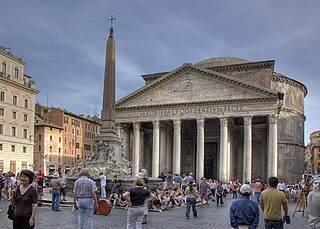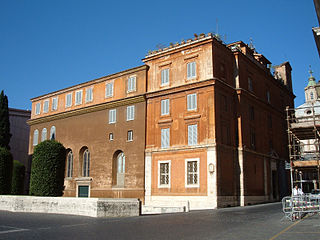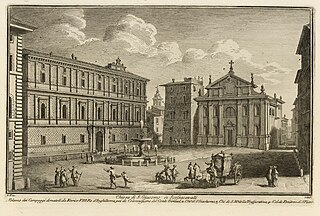
The Church of the Gesù is the mother church of the Society of Jesus (Jesuits), a Catholic religious order. Officially named Chiesa del Santissimo Nome di Gesù, its façade is "the first truly baroque façade", introducing the baroque style into architecture. The church served as a model for innumerable Jesuit churches all over the world, especially in the central Europe and then in the Portuguese colonies. Its paintings in the nave, crossing, and side chapels became models for Jesuit churches throughout Italy and Europe, as well as those of other orders. The Church of the Gesù is located in the Piazza del Gesù in Rome and is one of the great 17th century preaching churches built by Counter-Reformation orders in the Centro Storico.

Sant'Andrea della Valle is a titular church and minor basilica in the rione of Sant'Eustachio of the city of Rome, Italy. The basilica is the seat of the general curia of the Theatines and is located on the Piazza Vidoni, at the intersection of Corso Vittorio Emanuele and Corso Rinascimento. It is one of the great 17th century preaching churches built by Counter-Reformation orders in the Centro Storico.

Pigna is the 9th rione of Rome, Italy, identified by the initials R. IX, and belongs to the Municipio I. The name means "pine cone" in Italian, and the symbol of the rione is the colossal bronze pine cone standing in the middle of the homonymous fountain. The fountain, which was initially located in the Baths of Agrippa, now decorates a vast niche in the wall of the Vatican facing the Cortile della Pigna, located in Vatican City.

The Basilica of Saint Augustine in Camp Martius, commonly known as Basilica of Saint Augustine is a Catholic titular minor basilica in the Campus Martius area of Rome, Italy. Dedicated to Saint Augustine of Hippo it serves as the motherhouse of the Augustinian Friars.

There are more than 930 churches in Rome, which makes it the city with the largest number of churches in the world. Almost all of these are Catholic.

San Martino ai Monti, officially known as Santi Silvestro e Martino ai Monti, is a minor basilica in Rome, Italy, in the Rione Monti neighbourhood. It is located near the edge of the Parco del Colle Oppio, near the corner of Via Equizia and Viale del Monte Oppio, about five to six blocks south of Santa Maria Maggiore.

Filippo Barigioni (1690–1753) was an Italian sculptor and architect working in the Late Baroque tradition.

Santi Giovanni e Petronio dei Bolognesi is a Roman Catholic church in central Rome, Italy. It is named after the Saints John the Evangelist and Petronius, who are patrons of the city of Bologna. This church was made the "national church" of the Bolognese in Rome in 1581, by order of Pope Gregory XIII. It is located in the Rione of Regola, on Via del Mascherone, across the street and just south of the Gardens behind the Palazzo Farnese. It is today the "regional church" of Emilia-Romagna.

Santa Maria della Scala is a titular church in Rome, Italy, located in the Trastevere rione. It is served by friars of the Discalced Carmelite Order. Cardinal Ernest Simoni took possession of the titular church on 11 February 2017.

Santa Maria Scala Coeli is a Roman Catholic Church located on the grounds of the Tre Fontane Abbey located on Via di Acque Salvie 1 in the Quartiere Ardeatino in Rome. This is one of three churches affiliated with the Trappist monastery, and is located on a small lane, Via delle Tre Fontane, inside the abbey complex. The location of this church is held by tradition to be where St Paul the Apostle was imprisoned. on Via delle Tre Fontane in Rome.
Giovanni Antonio de' Rossi (1616–1695) was an Italian architect of the Baroque period, active mainly in Rome.

The Basilica of Saints John and Paul on the Caelian Hill is an ancient basilica church in Rome, located on the Caelian Hill. It was originally built in 398.

Santo Stefano de Pinea or more commonly Santo Stefano del Cacco is a church in Rome dedicated to Saint Stephen, located at Via di Santo Stefano del Cacco 26.

Eleutherius, also written as Eleutherus, Eleuterus and Eleftherios; sometimes called Liberalis or Liberator Greek: Ἐλευθέριος) and his mother Antia, or Anthia are venerated as Christian saints and martyrs in Greece and Italy.
This is an index of Vatican City–related topics.

The Church of Our Lady of Mercy in the Teutonic Cemetery is a Roman Catholic church in the rione Borgo of Rome, Italy. It is located on the Via della Sagrestia.

Jacopo Zoboli, also known by Giacomo, was an Italian painter of the Baroque style.

The Church of the Theatines (Teatini), also known as Santa Maria della Pietà is a Roman Catholic, Baroque-style church and monastery located on Corso della Giovecca, in central Ferrara, region of Emilia-Romagna, Italy.

San Giacomo Scossacavalli was a church in Rome important for historical and artistic reasons. The church, facing the Piazza Scossacavalli, was built during the early Middle Ages and since the early 16th century hosted a confraternity which commissioned Renaissance architect Antonio da Sangallo the Younger to build a new shrine. This was richly decorated with frescoes, painted by mannerist artist Giovanni Battista Ricci and his students. The church was demolished in 1937, when Via della Conciliazione was built and the piazza and central part of the Borgo rione were demolished. Many decorative elements still exist, since they were preserved from demolition.

The Palazzo Maffei Marescotti or Palace of the Vicariate is a religious building in Rome, Italy.





















